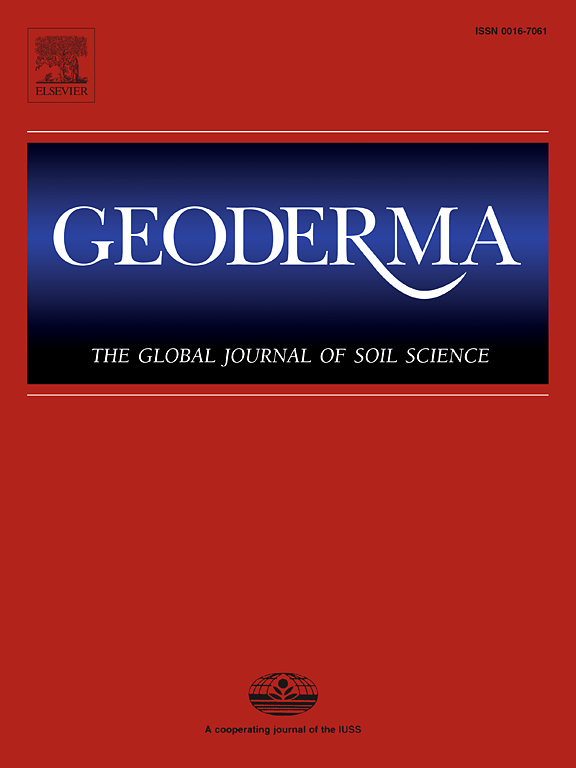结合遥感技术评估亚热带森林不同采样方案下的土壤真菌多样性
IF 5.6
1区 农林科学
Q1 SOIL SCIENCE
引用次数: 0
摘要
真菌是环境变化和压力因素的实时生物指标,对于在不断变化的全球环境下有效开展森林保护和管理至关重要。然而,对土壤真菌进行大规模评估仍然面临着挑战,即如何在大量取样成本和最小取样的有限准确性之间取得平衡。在本研究中,我们分析了从华东一个 25 公顷亚热带森林动态小区的 625 个四分格(20 m × 20 m)中采集的 1,606 份土壤样本。我们的主要目的是利用普通克里金(OK)和协同克里金(CoK)模型,结合遥感(RS)技术,探讨不同采样方案对土壤真菌多样性插值的影响。我们的研究结果表明,采样方案包括 0 米处的点(基点)和每个四分区内 8 米处的点,共计 26 个点/公顷,这样的采样方案就足够了。该方案与 OK 模型的结果与更密集的方案(0、2、5 和 8 米)相当,但所需的采样点最少。在将每个 RS 变量(包括两个植被指数(归一化差异植被指数和转化叶绿素吸收比指数 2)、三个地形属性(海拔高度、地势起伏和坡度))单独纳入 CoK 模型并对这些 RS 变量进行综合后,每个采样方案的预测结果的准确性都得到了进一步提高。通过将高精度土壤 DNA 测序与成本效益高的 RS 技术相结合,本研究提出了一种快速、经济的大规模监测土壤真菌多样性的方法。这将有助于收集数据,以了解森林土壤真菌对正在发生的全球变化的反应。本文章由计算机程序翻译,如有差异,请以英文原文为准。
Assessing soil fungal diversity under different sampling schemes in conjunction with remote sensing technologies in a subtropical forest
Fungi, serving as real-time bioindicators to environmental changes and stressors, are crucial for effective forest conservation and management practices under ongoing global change. However, the large-scale assessment of soil fungi still encounters challenges in striking a balance between the extensive sampling costs and the limited accuracy of minimal sampling. In this study, we analyzed 1,606 soil samples collected from 625 quadrats (20 m × 20 m) within a 25-ha subtropical forest dynamic plot in East China. Our primary objective was to explore the impact of different sampling schemes, in conjunction with remote sensing (RS) technologies, on the interpolation of soil fungal diversity using Ordinary Kriging (OK) and Co-kriging (CoK) models. Our findings suggested that a sampling scheme including points at 0 m (the base points) and 8 m within each quadrat, totaling to 26 points/ha, would be a sufficient scheme. This scheme with OK model yielded comparable results to those of more intensive schemes (at 0, 2, 5 and 8 m), but required the fewest sampling points. Upon incorporating each RS variable separately into the CoK models, including two vegetation indices (normalized difference vegetation index and transformed chlorophyll absorption ratio index 2), three terrain attributes (Elevation, Aspect and Slope), and the synthesis of these RS variables, the accuracy of the predicted results was further improved for each sampling scheme. By leveraging high-precision soil DNA sequencing in conjunction with cost-effective RS technologies, this study proposes a rapid and affordable approach for monitoring soil fungal diversity on a large scale. This will facilitate data collection for understanding responses of forest soil fungi to ongoing global change.
求助全文
通过发布文献求助,成功后即可免费获取论文全文。
去求助
来源期刊

Geoderma
农林科学-土壤科学
CiteScore
11.80
自引率
6.60%
发文量
597
审稿时长
58 days
期刊介绍:
Geoderma - the global journal of soil science - welcomes authors, readers and soil research from all parts of the world, encourages worldwide soil studies, and embraces all aspects of soil science and its associated pedagogy. The journal particularly welcomes interdisciplinary work focusing on dynamic soil processes and functions across space and time.
 求助内容:
求助内容: 应助结果提醒方式:
应助结果提醒方式:


